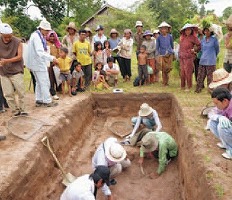
NABUNKEN NEWS vol.49
Ancient capitals of the Post-Angkor period calling for elucidation
The history of the Angkor dynasty (9 - 15 centuries), famous for the Angkor Wat, is gradually being uncovered through research of the many examples of stone architecture and inscriptions on monuments remaining in Cambodia. However, a large part of what is called "the Post-Angkor period", dating from the 15th century when Angkor was abandoned, to when made Cambodia a client state is still veiled in mystery due to poor historic records and poor implementation of consequent excavation investigations.
After Angkor was abandoned, the Khmer people changed their capital periodically throughout the Post-Angkor period; To Basan (Kampong Cham Province), Phnom Penh (the present capital), Longvek (Kampong Chhnang Province), and Udong (Kandal Province). Incidentally, according to Cambodian history, Longvek was constructed in the 16th century, and Udong was constructed in the 17th century.
As key to the "International Cooperation Project of Networking Core Centers in Conservation of Cultural Heritage" entrusted by the Agency for Cultural Affairs of Japan, the Ministry of Culture and Fine Arts, Cambodia and the Nara National Research Institute for Cultural Properties have begun a joint project targeting Longvek and Udong,. The project aims to; (i) implement archaeological investigations in the Longvek and Udong regions; and, (ii) transfer the techniques including underground exploration, surveying, excavation, artifacts-conservation treatment, etc., necessary for investigations, to the young Cambodian experts who have graduated from the Faculty of Archaeology of the Royal University of Fine Arts. We drew up a program through which these young researchers participating in the excavations, could learn such processes in the field as; (i) setting up survey control points related to the preparations and operations of excavation; (ii) topographical survey; (iii) exploration of a site; (iv) excavation; (v) recording; (vi) sorting-out; (vii) summary of results; and, (viii) conservation of artifacts.
First, we explored Longvek and Udong where it is still unclear how many and what structural remains have survived, and carried out surface collection and trial-digging investigations to create an inventory and map of the site. In consequence, it has become clear that there are more than 100 structural remains just in Longvek. Furthermore, upon receiving urgent information about unearthed artifacts from local people and at the request from the Ministry of Culture and Fine Arts, Cambodia, we also carried out an investigation and training program at Krang Kor, a village located 15 kilometers north-west of the central area of Longvek.
It is thought that Krang Kor was related to Longvek through history due to unearthed artifacts including ceramics, etc. that the Krang Kor residents have discovered in the past. Through excavations at this Krang Kor village, we turned up multiple graves with various burial articles including imported ceramic ware, local earthenware, an iron knife, glass beads, etc. The Krang Kor site has thus been established. In comparison with the present situation in which the Angkor Dynasty period garners much attention throughout the world, and thereby consequently international research and support concentrated on the Angkor complex in order to find the conditions at that time, the investigation of the Post-Angkor period has just started, and calls for further research.
This project has conducted investigation/training programs six times in total. So far, more than 50 young researchers have attended field training. We expect that in the near future, these young researchers, who undertook systematic training programs covering preparation, excavation, summary of result reports, sorting of artifacts, and artifacts-conservation treatment, would oversee excavations in Cambodia.
(TASHIRO Akiko, Department of Planning and Coordination)
 Investigations ongoing at the Krang Kor site |
